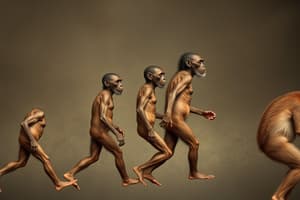Podcast
Questions and Answers
When did anatomically modern humans first arrive on the Indian subcontinent?
When did anatomically modern humans first arrive on the Indian subcontinent?
- Between 30,000 and 20,000 years ago
- Between 73,000 and 55,000 years ago (correct)
- Around 7000 BCE
- Between 2500 BCE and 1900 BCE
When did settled life begin in South Asia?
When did settled life begin in South Asia?
- Around 7000 BCE (correct)
- Between 73,000 and 55,000 years ago
- Between 30,000 and 20,000 years ago
- Between 2500 BCE and 1900 BCE
When did the Indus Valley civilization flourish?
When did the Indus Valley civilization flourish?
- Between 73,000 and 55,000 years ago
- Between 30,000 and 20,000 years ago
- Between 2500 BCE and 1900 BCE (correct)
- Around 600 BCE
When did the Vedic Period occur?
When did the Vedic Period occur?
What caused the population of the Indus Valley to scatter from large urban centres to villages?
What caused the population of the Indus Valley to scatter from large urban centres to villages?
Flashcards
Arrival of modern humans in India
Arrival of modern humans in India
Anatomically modern humans arrived on the Indian subcontinent between 73,000 and 55,000 years ago.
Start of settled life in South Asia
Start of settled life in South Asia
Settled life began in South Asia around 7000 BCE, marking the start of agriculture and permanent settlements.
Indus Valley Civilization Flourishing Period
Indus Valley Civilization Flourishing Period
The Indus Valley civilization flourished between 2500 BCE and 1900 BCE, known for its urban planning and trade.
Vedic Period Timeline
Vedic Period Timeline
Signup and view all the flashcards
Cause of Indus Valley population dispersal
Cause of Indus Valley population dispersal
Signup and view all the flashcards





